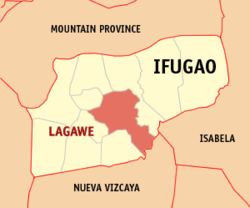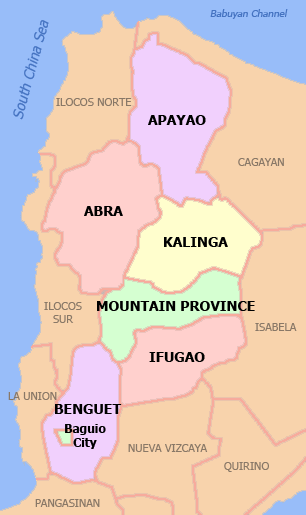Lagawe, Ifugao
Lagawe (Ilocano: Ili ti Lagawe), officially the Municipality of Lagawe is a 4th class municipality and capital of the province of Ifugao, Philippines. According to the 2015 census, it has a population of 19,333 people.[3]
Lagawe | |
|---|---|
| Municipality of Lagawe | |
 Seal | |
 Map of Ifugao with Lagawe highlighted | |

| |
.svg.png) Lagawe Location within the Philippines | |
| Coordinates: 16°49′N 121°06′E | |
| Country | |
| Region | Cordillera Administrative Region (CAR) |
| Province | Ifugao |
| District | Lone District |
| Founded | 1961 |
| Barangays | 20 (see Barangays) |
| Government | |
| • Type | Sangguniang Bayan |
| • Mayor | Martin L. Habawel, Jr. |
| • Vice Mayor | Reynold A. Kimayong |
| • Congressman | Solomon R. Chungalao |
| • Electorate | 11,895 voters (2019) |
| Area | |
| • Total | 208.91 km2 (80.66 sq mi) |
| Elevation | 490.2 m (1,608.3 ft) |
| Population (2015 census)[3] | |
| • Total | 19,333 |
| • Density | 93/km2 (240/sq mi) |
| • Households | 3,944 |
| Economy | |
| • Income class | 4th municipal income class |
| • Poverty incidence | 19.68% (2015)[4] |
| • Revenue (₱) | 85,847,702.37 (2016) |
| Time zone | UTC+8 (PST) |
| ZIP code | 3600 |
| PSGC | |
| IDD : area code | +63 (0)74 |
| Climate type | tropical rainforest climate |
| Native languages | Ifugao language Tuwali language Ilocano Tagalog |
| Website | www |
Barangays
Lagawe is politically subdivided into 20 barangays. [2]
- Abinuan
- Banga
- Boliwong
- Burnay
- Buyabuyan
- Caba
- Cudog
- Dulao
- Jucbong
- Luta
- Montabiong
- Olilicon
- Poblacion South
- Poblacion East
- Poblacion North
- Poblacion West
- Ponghal
- Pullaan
- Tungngod
- Tupaya
Climate
| Climate data for Lagawe, Ifugao | |||||||||||||
|---|---|---|---|---|---|---|---|---|---|---|---|---|---|
| Month | Jan | Feb | Mar | Apr | May | Jun | Jul | Aug | Sep | Oct | Nov | Dec | Year |
| Average high °C (°F) | 25 (77) |
26 (79) |
28 (82) |
30 (86) |
29 (84) |
29 (84) |
28 (82) |
28 (82) |
28 (82) |
28 (82) |
27 (81) |
26 (79) |
28 (82) |
| Average low °C (°F) | 18 (64) |
19 (66) |
20 (68) |
22 (72) |
23 (73) |
23 (73) |
23 (73) |
23 (73) |
23 (73) |
21 (70) |
20 (68) |
19 (66) |
21 (70) |
| Average precipitation mm (inches) | 38 (1.5) |
57 (2.2) |
77 (3.0) |
141 (5.6) |
390 (15.4) |
355 (14.0) |
426 (16.8) |
441 (17.4) |
426 (16.8) |
259 (10.2) |
97 (3.8) |
57 (2.2) |
2,764 (108.9) |
| Average rainy days | 10.4 | 12.1 | 15.4 | 20.4 | 26.7 | 27.1 | 28.7 | 28.0 | 26.4 | 19.9 | 14.1 | 12.3 | 241.5 |
| Source: Meteoblue [5] | |||||||||||||
Demographics
| Population census of Lagawe | ||
|---|---|---|
| Year | Pop. | ±% p.a. |
| 1939 | 13,204 | — |
| 1948 | 12,424 | −0.67% |
| 1960 | 13,694 | +0.81% |
| 1970 | 14,085 | +0.28% |
| 1975 | 13,948 | −0.20% |
| 1980 | 15,075 | +1.57% |
| 1990 | 12,437 | −1.91% |
| 1995 | 14,898 | +3.44% |
| 2000 | 15,269 | +0.53% |
| 2007 | 17,477 | +1.88% |
| 2010 | 18,077 | +1.24% |
| 2015 | 19,333 | +1.29% |
| Source: Philippine Statistics Authority[3][6][7][8] | ||
In the 2015 census, the population of Lagawe, Ifugao, was 19,333 people,[3] with a density of 93 inhabitants per square kilometre or 240 inhabitants per square mile.
References
- "Municipality". Quezon City, Philippines: Department of the Interior and Local Government. Retrieved 31 May 2013.
- "Province: Ifugao". PSGC Interactive. Quezon City, Philippines: Philippine Statistics Authority. Retrieved 12 November 2016.
- Census of Population (2015). "Cordillera Administrative Region (CAR)". Total Population by Province, City, Municipality and Barangay. PSA. Retrieved 20 June 2016.
- "PSA releases the 2015 Municipal and City Level Poverty Estimates". Quezon City, Philippines. Retrieved 12 October 2019.
- "Lagawe: Average Temperatures and Rainfall". Meteoblue. Retrieved 8 March 2020.
- Census of Population and Housing (2010). "Cordillera Administrative Region (CAR)". Total Population by Province, City, Municipality and Barangay. NSO. Retrieved 29 June 2016.
- Censuses of Population (1903–2007). "Cordillera Administrative Region (CAR)". Table 1. Population Enumerated in Various Censuses by Province/Highly Urbanized City: 1903 to 2007. NSO.
- "Province of Ifugao". Municipality Population Data. Local Water Utilities Administration Research Division. Retrieved 17 December 2016.
External links
| Wikimedia Commons has media related to Lagawe, Ifugao. |
This article is issued from Wikipedia. The text is licensed under Creative Commons - Attribution - Sharealike. Additional terms may apply for the media files.
